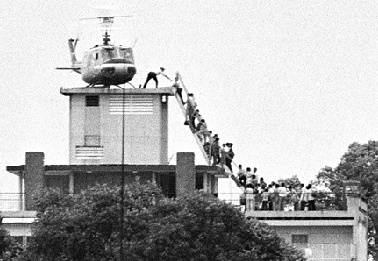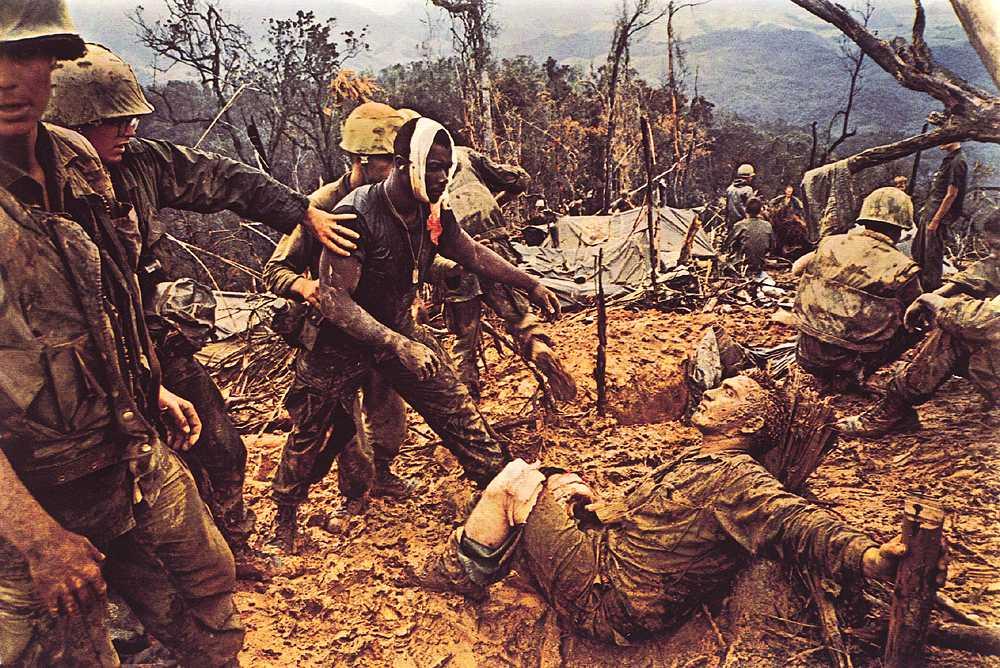THE PHOTO JOURNALISTS OF THE VIETNAMESE WAR
"GOOOOD MORNING VIETNAAM!"
BY ROBIN WILLIAMS
" Like Van Es, many of us who covered the war found ourselves forever in the grip of Vietnam. No other story, no other war, quite measured up. The exotic charm and dangerous undercurrents of Saigon were seductive, the adrenaline rush of survival intoxicating. We hitchhiked around the country on military helicopters and roamed the battlefields without censorship. The Associated Press lists 73 of our colleagues as killed in South Vietnam, Cambodia, and Laos, yet as individuals we felt invulnerable" by David Lamb, Smithsonian Magazine
The photo journalist is part documenter, reporter, and artist. They must have the skill of a professional photographer, the ability to be a news reporter in the field, and an artist in the images they capture. And in addition to that they had to have nerves of steel to go into the jungles, and rice patties, on the front line where the battles raged.
Vietnam was the first war censorship was not a factor, as in World War II and later wars. It opened up freedom to the taking of photo's that revealed the true war and the conditions our soldiers were enduring. It allowed the truth to be told in black and white pictures in the press daily. Moving film was sent daily into the living rooms of Americans across the country and the ever famous body count.
Photo Journalists in the Vietnamese war(click for more info.)
were remarkable men who risked their lives, many died trying to get the right picture to show the conflict, the confusion, doubt, violence, and despair of the men who fought this war and the tragedy of war on both sides. Who are some of these remarkable men and what photographs are they known for? Lets take a look at a few. Every name is clickable to link you to more information on each photo journalist. Not all photo journalists will be covered in this post, we will continue until we have covered the most mentioned of the period.
I thought we would start with a film from You Tube which shows the feel of this war for the soldiers, news reporters, and photo journalist. To appreciate what they did to report the war and risks their lives for the photographs they took it is important we put ourselves back in that time and place. This film does that fairly well. It is a long video, you may want to watch parts and come later to the whole film. I think the absolute violence of war is beyond anyones understanding unless they have been there, but film and photo's help bring it closer for us to understand. I remember being absolutely riveted by the opening scene is Saving Private Ryan, where the sounds and speed with which things happened is almost unbelievable. Film below…..
Eddie Adams
Larry Burrows
Van Es
Dickey Chapelle
"Dickey Chapelle covered the battles of Iwo Jima and Okinawa for National Geography, was captured and jailed for seven weeks covering the Hungarian uprising for Life. In the meantime, she learned to fly an airplane and jump with paratroopers. She arrived in Vietnam in the early '60's and described her early experiences in her 1962 book "What's a Woman Doing Here?" On November 4, 1965 when on patrol with a Marine platoon, the soldier in front of Chapelle activated a booby trap( a mortar shell with a hand grenade The explosion hurled Chapelle off her feet, and a piece of the shrapnel slit her carotid artery, wounding her mortally."
Dick Ut
The video below is from Rolling Stone Magazine, called Paint it Black. It shows the division and frustration of a nation at war.
The music and art of the period reflects the culture and mood of the times.
Click here for a list of songs about the Vietnam War
Click here for a list of films about the Vietnam War
Horst Faas
Fred Waters
Frank Capa
"While collectively news photography from Vietnam
constituted a potent archive of a new kind of photography suited to a new kind of war and produced imagery that challenged the ideology and course of the American mission, a great deal of work was produced as spot news imagery with a conventionalized form of professional practice.
There were, however, notable exceptions, photographers who worked more self-consciously to push the boundaries of photojournalistic practice. Their work reflects on the contexts and scenery of war and, while these had varied motivations and were often constrained by the broader media and state frames, they did develop the genre of photojournalism, adapting it to new conditions of warfare and technological production.
These photographers produced a more meditative form of photojournalism, an afterimagery of conflicts and contexts, bound not to spot news reporting but to a more investigative framing of events. I am thinking here of photographers such as Larry Burrows, Philip Jones Griffiths, Don McCullin, Catherine Leroy, Kyoichi Sawada and Henri Huet.
In Vietnam, photographers had opportunities to develop a fresh visual awareness about war and its representations, especially those who stayed for long periods or who came with investigative intent. Within the mass visual coverage of this war were examples o
f this new awareness, the work of photographers reflexively attuned to the style and ethos of their work as a subjective register of their relation to the war. These photographers opened up opportunities for a more expressive form of documentary representation and influenced the style of a new generation of photojournalists who emerged to prominence in the 1970s and 1980s."
article source and quote from Liam Kennedy, Clinton Institute
Louis Armstrong…what a Beautiful World in concert in Vietnam
click below.
"GOOOOD MORNING VIETNAAM!"
BY ROBIN WILLIAMS
 |
| Iconic Image By Van Es, Photo journalist of Vietnamese War The Last Helicopter Leaving Vietnam from google for the sole purpose of education and art advocacy |
" Like Van Es, many of us who covered the war found ourselves forever in the grip of Vietnam. No other story, no other war, quite measured up. The exotic charm and dangerous undercurrents of Saigon were seductive, the adrenaline rush of survival intoxicating. We hitchhiked around the country on military helicopters and roamed the battlefields without censorship. The Associated Press lists 73 of our colleagues as killed in South Vietnam, Cambodia, and Laos, yet as individuals we felt invulnerable" by David Lamb, Smithsonian Magazine
The photo journalist is part documenter, reporter, and artist. They must have the skill of a professional photographer, the ability to be a news reporter in the field, and an artist in the images they capture. And in addition to that they had to have nerves of steel to go into the jungles, and rice patties, on the front line where the battles raged.
Vietnam was the first war censorship was not a factor, as in World War II and later wars. It opened up freedom to the taking of photo's that revealed the true war and the conditions our soldiers were enduring. It allowed the truth to be told in black and white pictures in the press daily. Moving film was sent daily into the living rooms of Americans across the country and the ever famous body count.
Photo Journalists in the Vietnamese war(click for more info.)
were remarkable men who risked their lives, many died trying to get the right picture to show the conflict, the confusion, doubt, violence, and despair of the men who fought this war and the tragedy of war on both sides. Who are some of these remarkable men and what photographs are they known for? Lets take a look at a few. Every name is clickable to link you to more information on each photo journalist. Not all photo journalists will be covered in this post, we will continue until we have covered the most mentioned of the period.
 |
| Poster Protest Art of the Vietnamese War at home from google for education only |
 |
| Poster Art from Army Recruiters from google for education only |
I thought we would start with a film from You Tube which shows the feel of this war for the soldiers, news reporters, and photo journalist. To appreciate what they did to report the war and risks their lives for the photographs they took it is important we put ourselves back in that time and place. This film does that fairly well. It is a long video, you may want to watch parts and come later to the whole film. I think the absolute violence of war is beyond anyones understanding unless they have been there, but film and photo's help bring it closer for us to understand. I remember being absolutely riveted by the opening scene is Saving Private Ryan, where the sounds and speed with which things happened is almost unbelievable. Film below…..
Eddie Adams
 |
| Eddie Adams from google sole purpose is education |
Larry Burrows
 |
| Larry Burrows photo is worthy of Renaissance painting of drama and choreography From google only for education |
 |
| Van Es from google only for education |
 |
| Dickey Chapelle Photo from google only for education and art education |
Dick Ut
 |
| Dick Ut Iconic photo of Kim Phuc after Napalm bombing from google for education only |
The music and art of the period reflects the culture and mood of the times.
Click here for a list of films about the Vietnam War
Horst Faas
 |
| Photo by Horst Faas from google for education only |
Fred Waters
 |
| Fred Waters Photo from google image for education purposes only |
Frank Capa
 |
| Frank Capa famous WWII photo journalist went on to Viet Nam where he lost his life. from google image for education only |
constituted a potent archive of a new kind of photography suited to a new kind of war and produced imagery that challenged the ideology and course of the American mission, a great deal of work was produced as spot news imagery with a conventionalized form of professional practice.
There were, however, notable exceptions, photographers who worked more self-consciously to push the boundaries of photojournalistic practice. Their work reflects on the contexts and scenery of war and, while these had varied motivations and were often constrained by the broader media and state frames, they did develop the genre of photojournalism, adapting it to new conditions of warfare and technological production.
These photographers produced a more meditative form of photojournalism, an afterimagery of conflicts and contexts, bound not to spot news reporting but to a more investigative framing of events. I am thinking here of photographers such as Larry Burrows, Philip Jones Griffiths, Don McCullin, Catherine Leroy, Kyoichi Sawada and Henri Huet.
In Vietnam, photographers had opportunities to develop a fresh visual awareness about war and its representations, especially those who stayed for long periods or who came with investigative intent. Within the mass visual coverage of this war were examples o
f this new awareness, the work of photographers reflexively attuned to the style and ethos of their work as a subjective register of their relation to the war. These photographers opened up opportunities for a more expressive form of documentary representation and influenced the style of a new generation of photojournalists who emerged to prominence in the 1970s and 1980s."
article source and quote from Liam Kennedy, Clinton Institute
 |
| Propaganda Art from Vietnam from google for education |
Louis Armstrong…what a Beautiful World in concert in Vietnam
click below.

No comments:
Post a Comment